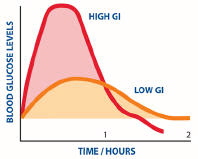
Glycemic Index Table
Glycemic Index is an important consideration whenever choosing which foods to eat.
Avoid the Blood Sugar Level Spike that Causes Health Problems
Whenever sugar levels goes up in the blood it causes the body a large amount of work. With rapid rises in blood sugar, the body essentially goes into a panic mode to get the sugar out of the blood. The reason the body reacts so swiftly to blood sugar level rise is that sugar causes glycation of our proteins, cross-linking proteins and sugars with the result that the protein molecules don’t function perfectly anymore. that sugar causes glycation of our proteins, cross-linking proteins and sugars with the result that the protein molecules don’t function perfectly anymore.
This is a significant cause of cellular damage and aging. This is why diabetics statistically have reduced longevity and why diabetics have problems in so many areas — the proteins in diabetics’ bodies are constantly being damaged by sugar.
The way the body gets sugar levels under control is to convert sugar to fat. Insulin is the hormone that helps this occur. There is a high degree of correlation between obesity and high blood sugar levels. Anytime the blood sugar is above 105, the body is going to be storing the excess sugar as fat (unless one’s cells have become insulin resistance, in which case, blood sugar rises and disease results).
Bottom line: A major effort at keeping our bodies healthy is to keep our blood free of excess sugar. This is best done by eating predominately low glycemic foods, and to eat occasional high glycemic foods with a preponderance of low-glycemic foods and to eat smaller portions of food.
Low glycemic index foods promote a slow to moderate rise in blood sugar and insulin as they're digested. Because of this, appetite is reduced and the body is actually encouraged to burn body fat.
There are great benefits associated with eating virtually exclusively low glycemic foods.
The benefits of eating low glycemic foods include all of the following:
- Reduced risk of heart disease, diabetes, and obesity
- Increased energy & improved metabolism
- Weight loss
- Prevents overeating & reduces hunger pains
- Controls or moderates blood sugar & insulin levels
How To Interpret the Below Glycemic Index Table
- Foods that have a glycemic index value of up to 40 are Low Glycemic Foods. These are smart foods to eat because they don’t raise blood sugar quickly.
- Foods that have a Glycemic index value of between 41 to 55 are Moderate Glycemic Foods. These foods are generally safe foods in terms of not spiking blood sugar (except for people with insulin resistance).
- Foods that have a Glycemic index value between 55 to 70 are High Glycemic Foods. They are best eaten with low or very low glycemic foods in order to help slow blood sugar release; and to eat no more than two servings per day of these foods.
- Foods that have a Glycemic value above 70 are Very High Glycemic Foods and should be eaten no more than one serving a few times per month and always with low and moderate glycemic foods.
Glycemic Index of
Cereals
Kellogg's All Bran 51
Kellogg's Bran Buds 45
Kellogg's Cornflakes 84
Kellogg's Rice Krispies 82
Kellogg's Special K 54
Oatmeal 49
Shredded Wheat 67
Quaker Puffed Wheat 67
Glycemic Index of
Grains
Buckwheat 54
Bulgur 48
Basmati Rice 58
Brown Rice 55
Long grain White Rice 56
Short grain White Rice 72
Uncle Ben's Converted 44
Noodles (instant) 46
Taco Shells 68
Glycemic Index of
Fruit
Apple 38
Banana 55
Cantaloupe 65
Cherries 22
Grapefruit 25
Grapes 46
Kiwi 52
Mango 55
Orange 44
Papaya 58
Pear 38
Pineapple 66
Plum 39
Watermelon 103
Glycemic Index of
Vegetables
Beets 69
Broccoli 10
Cabbage 10
Carrots 49
Corn 55
Green Peas 48
Lettuce 10
Mushrooms 10
Onions 10
Parsnips 97
Potato (baked) 93
Potato (mashed, instant) 86
Potato (new) 62
Potato (french fries) 75
Red Peppers 10
Pumpkin 75
Sweet Potato 54
Glycemic Index of
Beans
Baked Beans 48
Broad Beans 79
Cannellini Beans 31
Garbanzo Beans (Chickpeas) 33
Lentils 30
Lima Beans 32
Navy Beans 38
Pinto Beans 39
Red Kidney Beans 27
Soy Beans 18
White Beans 31
|
Glycemic Index of
Pasta
Spaghetti 43
Ravioli (meat) 39
Fettuccini (egg) 32
Spiral Pasta 43
Capellini 45
Linguine 46
Macaroni 47
Rice vermicelli 58
Glycemic Index of
Breads
inc. Muffins & Cakes
Bagel 72
Blueberry Muffin 59
Croissant 67
Donut 76
Pita Bread 57
Pumpernickel Bread 51
Rye Bread 76
Sour Dough Bread 52
Sponge Cake 46
Stone Ground Whole wheat bread 53
Waffles 76
White Bread 70
Whole Wheat Bread 69
Glycemic Index of
Dairy
Milk (whole) 22
Milk (skimmed) 32
Milk (chocolate flavored) 34
Ice Cream (whole) 61
Ice cream (low-fat) 50
Yogurt (low-fat) 33
Glycemic Index of
Snacks
Cashews 22
Chocolate Bar 49
Corn Chips 72
Jelly Beans 80
Peanuts 14
Popcorn 55
Potato Chips 55
Pretzels 83
Snickers Bar 41
Walnuts 15
Glycemic Index of
Cookies
Graham Crackers 74
Kavli Crispbread 71
Melba Toast 70
Oatmeal Cookies 55
Rice Cakes 82
Rice Crackers 91
Ryvita Crispbread 69
Soda Crackers 74
Shortbread Cookies 64
Stoned Wheat Thins 67
Water crackers 78
Glycemic Index of
Sugars
Fructose 23
Glucose 100
Honey 58
Lactose 46
Maltose 105
Sucrose 65
|
|
 that sugar causes glycation of our proteins, cross-linking proteins and sugars with the result that the protein molecules don’t function perfectly anymore.
that sugar causes glycation of our proteins, cross-linking proteins and sugars with the result that the protein molecules don’t function perfectly anymore.